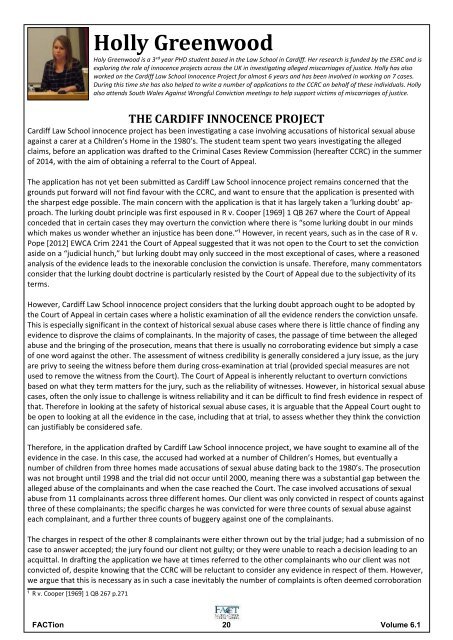FACTion-6.1-web-version
FACTion-6.1-web-version
FACTion-6.1-web-version
You also want an ePaper? Increase the reach of your titles
YUMPU automatically turns print PDFs into web optimized ePapers that Google loves.
Holly GreenwoodHoly Greenwood is a 3 year PHD student based in the Law School in Cardiff. Her research is funded by the ESRC and isexploring the role of innocence projects across the UK in investigating alleged miscarriages of justice. Holly has alsoworked on the Cardiff Law School Innocence Project for almost 6 years and has been involved in working on 7 cases.During this time she has also helped to write a number of applications to the CCRC on behalf of these individuals. Hollyalso attends South Wales Against Wrongful Conviction meetings to help support victims of miscarriages of justice.THE CARDIFF INNOCENCE PROJECTCardiff Law School innocence project has been investigating a case involving accusations of historical sexual abuseagainst a carer at a Children’s Home in the 1980’s. The student team spent two years investigating the allegedclaims, before an application was drafted to the Criminal Cases Review Commission (hereafter CCRC) in the summerof 2014, with the aim of obtaining a referral to the Court of Appeal.The application has not yet been submitted as Cardiff Law School innocence project remains concerned that thegrounds put forward will not find favour with the CCRC, and want to ensure that the application is presented withthe sharpest edge possible. The main concern with the application is that it has largely taken a ‘lurking doubt’ approach.The lurking doubt principle was first espoused in R v. Cooper [1969] 1 QB 267 where the Court of Appealconceded that in certain cases they may overturn the conviction where there is “some lurking doubt in our mindswhich makes us wonder whether an injustice has been done.”¹ However, in recent years, such as in the case of R v.Pope [2012] EWCA Crim 2241 the Court of Appeal suggested that it was not open to the Court to set the convictionaside on a “judicial hunch,” but lurking doubt may only succeed in the most exceptional of cases, where a reasonedanalysis of the evidence leads to the inexorable conclusion the conviction is unsafe. Therefore, many commentatorsconsider that the lurking doubt doctrine is particularly resisted by the Court of Appeal due to the subjectivity of itsterms.However, Cardiff Law School innocence project considers that the lurking doubt approach ought to be adopted bythe Court of Appeal in certain cases where a holistic examination of all the evidence renders the conviction unsafe.This is especially significant in the context of historical sexual abuse cases where there is little chance of finding anyevidence to disprove the claims of complainants. In the majority of cases, the passage of time between the allegedabuse and the bringing of the prosecution, means that there is usually no corroborating evidence but simply a caseof one word against the other. The assessment of witness credibility is generally considered a jury issue, as the juryare privy to seeing the witness before them during cross-examination at trial (provided special measures are notused to remove the witness from the Court). The Court of Appeal is inherently reluctant to overturn convictionsbased on what they term matters for the jury, such as the reliability of witnesses. However, in historical sexual abusecases, often the only issue to challenge is witness reliability and it can be difficult to find fresh evidence in respect ofthat. Therefore in looking at the safety of historical sexual abuse cases, it is arguable that the Appeal Court ought tobe open to looking at all the evidence in the case, including that at trial, to assess whether they think the convictioncan justifiably be considered safe.Therefore, in the application drafted by Cardiff Law School innocence project, we have sought to examine all of theevidence in the case. In this case, the accused had worked at a number of Children’s Homes, but eventually anumber of children from three homes made accusations of sexual abuse dating back to the 1980’s. The prosecutionwas not brought until 1998 and the trial did not occur until 2000, meaning there was a substantial gap between thealleged abuse of the complainants and when the case reached the Court. The case involved accusations of sexualabuse from 11 complainants across three different homes. Our client was only convicted in respect of counts againstthree of these complainants; the specific charges he was convicted for were three counts of sexual abuse againsteach complainant, and a further three counts of buggery against one of the complainants.The charges in respect of the other 8 complainants were either thrown out by the trial judge; had a submission of nocase to answer accepted; the jury found our client not guilty; or they were unable to reach a decision leading to anacquittal. In drafting the application we have at times referred to the other complainants who our client was notconvicted of, despite knowing that the CCRC will be reluctant to consider any evidence in respect of them. However,we argue that this is necessary as in such a case inevitably the number of complaints is often deemed corroboration¹ R v. Cooper [1969] 1 QB 267 p.271<strong>FACTion</strong> 20 Volume <strong>6.1</strong>


